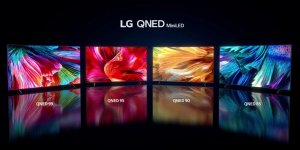
It's difficult to distinguish between the two names due to their similarity in pronunciation. Let us explain the distinctions between these two television technologies so you can decide which is preferable for your home.
QNED

QNED is the name LG has given to their quantum dot-equipped (Q), NanoCell (N) "emitting diode (ED)" TVs, which were available in 2021. We don't blame you if you're scratching your head over this one. However, in competition, Samsung accomplished it first with "QLED."
On paper, QNED TVs seem to provide a winning mix of technology, despite the complex nomenclature structure. These are standard LED/LCD televisions, but they are additionally outfitted with quantum dots (explained above). They also have LG's unique NanoCell technology, which the firm claims as particles that absorb undesirable light wavelengths. Finally, they have mini-LED backlights.
While the details get more complicated as you go deeper, the main thing to know about "QNED" is that you're getting a quantum dot version of LG's famous NanoCell TVs. It is an LG TV if it says "QNED."
OLED

LG makes OLED TVs, and the OLED55C9P, LG's response to OLED, was introduced in 2016. The 3,000:1 contrast ratio on these TVs is superior to that of previous models. This is one of the most expensive flat-screen TVs currently on the market.
The colors on this model have incredible contrast, flawless gradation, and great saturation because of its wide color gamut. You can adjust the display and its natural color output since it's slightly similar to a plasma TV's image.
Unlike OLEDs, plasmas use a different backlighting technique for their LEDs. Each pixel can be turned off separately, so OLED screens can achieve the optimum contrast.
Other Benefits of Using OLEDs
Additionally, these TVs are superior in contrast to LED/LCD televisions. In contrast to LCD versions, OLED TVs don't need extra technologies like color phosphors or quantum dots to provide vibrant colors. To reduce the thickness of OLED TVs, they don't require a backlight or a variety of transistor/stabilizing layers inside the screen.
The Argument: QNED vs. OLED
OLED TVs continue to be the best, despite LG's use of QNED, one of the company's newest TV technologies. A statement in an LG news release even recognizes this. Independent dimming control is the most significant distinction between QNED and OLED. Dimmable light bulbs are still used in QNED TVs despite the fact that they contain several dimming zones. It is possible to generate a larger range of colors or no color using organic, carbon-based material in OLED TVs. Individual OLED pixels can be turned off, whereas QNED pixels can only be dimmed. This means that OLED TVs offer the greatest blacks since individual pixels can be turned off.
OLED TVs provide the best image quality; thus, those looking for the most expensive TV should get one of them. OLED TVs are excellent choices for individuals who do not want to spend a lot of money. The reality is that fantastic TVs are available at all price levels. Simple online searches reveal that buyers have a wide range of possibilities. Purchases of models from previous years are wise since they may be much less expensive than current models. At the same time, yearly advances in TVs are substantially less in comparison. Even while it may take a long time for the price of QNED TVs to drop significantly, it's an option to consider waiting for an earlier model.
Summary
Samsung's research on QNED has surely given OLED a wake-up call since some experts feel that OLED self-luminous display technology is the greatest option for the next-generation mainstream technology. It is well-known that Samsung has a large OLED technological reserve; nonetheless, the company seems to be hedging its bets and investing in LED technology.
Other minor variations between the two devices include reaction time, native refresh rates, and price. For example, higher display quality on OLED TVs drives up the price. To get the most bang for your buck, an OLED TV is your preferred alternative. In contrast, a QNED television is the best option if you are interested in pixel material and pixel technology with little care about price.



